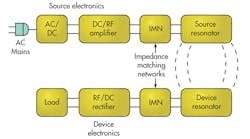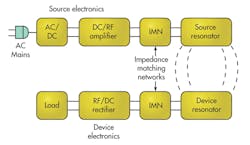This file type includes high resolution graphics and schematics when applicable.
Ever since Nikola Tesla introduced the prospect of wireless power transfer almost 100 years ago, there has been considerable investment in implementing such systems in the US. Now, it appears that society and market demands are finally in place to make Tesla’s vision a reality. There are currently many methods to power devices wirelessly. All of these approaches invite concerns over distance, efficiency, safety, power-handling capability, and cost. Dr. Morris Kesler shares the ins and outs of highly resonant wireless power transfer in a 32-page application note titled, “Highly Resonant Wireless Power Transfer: Safe, Efficient, and over Distance.”
Highly resonant wireless power transfer (HR-WPT) uses high-quality-factor resonators to enable the efficient, long-range, and non-radiative transfer of electromagnetic (EM) energy. This method proposes to solve a significant portion of the safety and efficiency concerns surrounding other wireless-power-transfer methods. HR-WPT requires a power source, AC/DC converter, DC/RF amplifier, impedance-matching network, and a resonant antenna for the transmitter. The receiver uses the same components in a receiver configuration. This construction allows efficiencies that are close to optimal.
Many industries and technology platforms could benefit from this method of providing power. On the consumer side, examples include mobile handsets, TVs, rechargeable batteries, and computers. Industrial, automotive, medical-appliance, and military-equipment manufacturers also could take advantage of the increased accessibility, reliability, and safety of remotely powered devices.
There are key benefits to HR-WPT from a flexibility and modularity perspective over other WPT technologies. With HR-WPT, the orientation of the receiving device and its relative scale compared to the transmitter only minimally affects the efficiency of the transfer. This is not the case with inductive coil or radiative technology. Additionally, two enabling benefits of HR-WPT are its ability to charge multiple devices from a single transmitter and use highly efficient resonant repeaters. The increased capabilities of HR-WPT could put high levels of RF energy in close proximity to the end user.
In addition, HR-WPT has the capability to transfer energy from watts to kilowatts. Naturally, this aspect raises the concern of human bodies and other devices being harmed by wireless power. In simulations, the HR-WPT method of transfer has been found to exhibit levels of tissue heating, nerve/muscle stimulation, and specific absorption rates that are far below the FCC SAR and ICNIRP electric field guidelines.
WiTricity, 149 Grove St., Watertown, MA 02472; (617) 926-2700.
This file type includes high resolution graphics and schematics when applicable.


